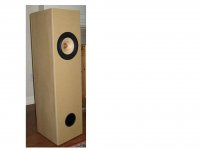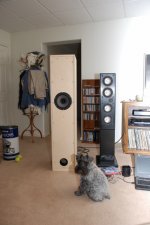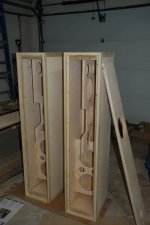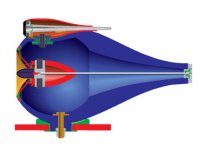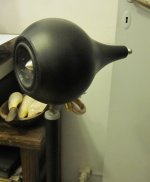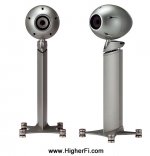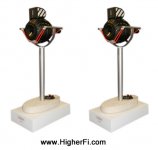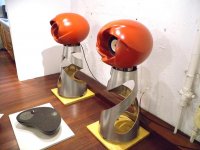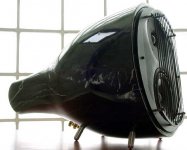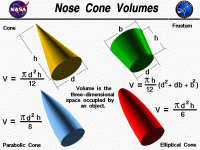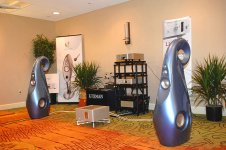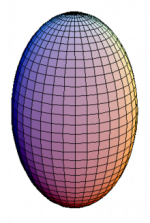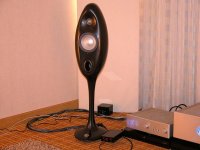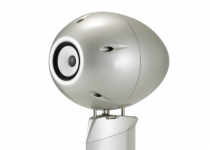Hi guys. I have been doing some reading on t/s parameters, speaker modeling and threads on this forum. I am thinking of building a spherical enclosure on a 20" diameter mold. My math puts the volume at about 68 liters. If i am wrong, please correct me. So, after some research, i need a driver with an ebp of 50 or less. Having a heck of a time finding one. There are a couple of inexpensive 8" ers at parts express and that's all i can find. Fostex, TB, Alpair are all well over 100, some well over 200. There are a couple of AN drivers under 100. Anyway, can anyone recommend a driver for this experiment that has at least an even chance of sounding good?? This will be my first speaker project so want at least a fair shot of success. Thanks for any input. Regards, J.D.
My first thoughts are that you might do something like this.
I am building some speakers that have to fit into 18" globes for my Clairtone Project G build. From the advice garnered from this forum I decided to use the Alpair 12 in a fonken style cabinet designed by Dave Duglos of Planet 10, the Mar-Ken 12 octagon. This will be mounted within the globe.
They sound awesome!
These are the threads that depict my efforts to date.
http://www.diyaudio.com/forums/markaudio/196778-mar-ken-12-octagon.html
http://www.diyaudio.com/forums/full-range/193334-begginings-my-clairtone-globes.html
I am building some speakers that have to fit into 18" globes for my Clairtone Project G build. From the advice garnered from this forum I decided to use the Alpair 12 in a fonken style cabinet designed by Dave Duglos of Planet 10, the Mar-Ken 12 octagon. This will be mounted within the globe.
They sound awesome!
These are the threads that depict my efforts to date.
http://www.diyaudio.com/forums/markaudio/196778-mar-ken-12-octagon.html
http://www.diyaudio.com/forums/full-range/193334-begginings-my-clairtone-globes.html
My concerns with this structure would be internal reflections off the interior....the waves coming directly back to their source, some in phase making for a resonant peak. I would be breaking up the interior randomly to minimize internal waves.
Perhaps one could fill the globe with a rubber adhesive compound....& then reach in with your hand & break out chunks, hollowing it out. The randomness of your "removal process" would not be so 'perfect'. It would just have to stick tightly to the interior.
Or stacks of 1" thick cork?
______________________________________________________Rick.........
Perhaps one could fill the globe with a rubber adhesive compound....& then reach in with your hand & break out chunks, hollowing it out. The randomness of your "removal process" would not be so 'perfect'. It would just have to stick tightly to the interior.
Or stacks of 1" thick cork?
______________________________________________________Rick.........
Why a sealed sphere?
jds: Why a sealed sphere? You could use a variovent to make a restrictive port design. This is perhaps the best of both worlds:
jds: Why a sealed sphere? You could use a variovent to make a restrictive port design. This is perhaps the best of both worlds:
- smaller enclosure
- can use almost any driver (within reason)
- and most importantly it helps create a very benign impedance curve
regarding the math, Volume of a sphere: V=4/3*Π*r³
r=10" or 25.4 cm
substituting into the volume equation yields approx 68.642 litres
For drivers, there is one that I know of for sure that will work in a sealed enclosure, the SEAS Exotic F8 full range driver, but they are quite expensive! (£1200/pair) if still available. You could consider the Pioneer "BOFU" driver. EPB is 85, Vas=64 litres.
I think you are going about this in reverse. Pick a driver, see if it will work in the volume you want and then go from there. Consider the projects as per Douglas Ingram. In particular the Onken style Hexagons designed by Dave Dlugos. They seem to be something like what you may be after. One thing that many full rangers have is a very high Q.
If a globe is needed, a couple of wooden bowls can be used to good effect, although finding 4 with a diameter 20" could be a problem. I think that as you look around it will become apparent that you reallt do need to settle on drivers first (and the correct budget to get what you want) and then design something around them, or build a suitable enclosure using a driver that can be used in a BR, Onken or "Lossy" sealed box (Variovent)
Hi guys. I have been doing some reading on t/s parameters, speaker modeling and threads on this forum. I am thinking of building a spherical enclosure on a 20" diameter mold. My math puts the volume at about 68 liters. If i am wrong, please correct me. So, after some research, i need a driver with an ebp of 50 or less. Having a heck of a time finding one. There are a couple of inexpensive 8" ers at parts express and that's all i can find. Fostex, TB, Alpair are all well over 100, some well over 200. There are a couple of AN drivers under 100. Anyway, can anyone recommend a driver for this experiment that has at least an even chance of sounding good?? This will be my first speaker project so want at least a fair shot of success. Thanks for any input. Regards, J.D.
Last edited:
Hi T.D.
My best sounding, acceptable cabinet format, full range speakers use a MLTL design with an 8" full range speaker (Tang Band W8-1808).
There are several white papers on the value of the sphere + tapered tube shape for a wide bandwidth midrange. B&W is perhaps the best example. I have been looking at the AES Lambda TD6M and future TD8M (or TD8LO) as "rich sounding" wide bandwidth midranges for sphere+tube midbass.
With full range light cone (9-10g Mms) 8" speakers like the W8-1808 I hear great detail and frequency extension. With more robust paper cones like the Lambda TD10M I hear rich male voices and more impact, but less extension/detail. I'm waiting for a Lambda TD8LO to test for a large sphere + tube midbass to suspend over Lambda TD15S woofers. The SB29RDCN-C000-4 tweeter is a good sounding, very small size dome tweeter for mounting above the sphere.
My best sounding, acceptable cabinet format, full range speakers use a MLTL design with an 8" full range speaker (Tang Band W8-1808).
There are several white papers on the value of the sphere + tapered tube shape for a wide bandwidth midrange. B&W is perhaps the best example. I have been looking at the AES Lambda TD6M and future TD8M (or TD8LO) as "rich sounding" wide bandwidth midranges for sphere+tube midbass.
With full range light cone (9-10g Mms) 8" speakers like the W8-1808 I hear great detail and frequency extension. With more robust paper cones like the Lambda TD10M I hear rich male voices and more impact, but less extension/detail. I'm waiting for a Lambda TD8LO to test for a large sphere + tube midbass to suspend over Lambda TD15S woofers. The SB29RDCN-C000-4 tweeter is a good sounding, very small size dome tweeter for mounting above the sphere.
Attachments
You can estimate the volume of a truncated sphere with this equation:
(you must substract the speak's rear volume and account for stuffing)
r is the radius of the cabinet sphere
x is the radius of the front speaker baffle hole
The rear tapered tube volume is not calculated.
PI * r * 2*x + 2/3 * PI * r^3 - 1/3 * PI * x^3
For
r = 10" interior radius of sphere
x = 4" radius of 8" speaker baffle cut out
volume = 3285 cu in = 1.9 cu ft = 53.8 cu liters
1 cubic foot = 28.3168 liters
NASA has rocket nose cone volume equations.
(you must substract the speak's rear volume and account for stuffing)
r is the radius of the cabinet sphere
x is the radius of the front speaker baffle hole
The rear tapered tube volume is not calculated.
PI * r * 2*x + 2/3 * PI * r^3 - 1/3 * PI * x^3
For
r = 10" interior radius of sphere
x = 4" radius of 8" speaker baffle cut out
volume = 3285 cu in = 1.9 cu ft = 53.8 cu liters
1 cubic foot = 28.3168 liters
NASA has rocket nose cone volume equations.
Attachments
Last edited:
Betsy and Betsy-K, and Seas...
the Betsy is suitable , with Fs=49.63 and Qes=0.945, so EBP of about 53. The Betsy-K similar Fs, but Qes=0.548, so EBP of about 90. (an EBP between 50 and 100 can be used in either a Sealed or BR cabinet)
The BOFU could be the budget contender ($14 ea.). as I have no modelling software on my iMac, I can't model it, but it should be OK. (Online calculators using the posted parameters result in a sealed enclosure with a volume of 31 litres, and f3 of 69Hz)
the Betsy is suitable , with Fs=49.63 and Qes=0.945, so EBP of about 53. The Betsy-K similar Fs, but Qes=0.548, so EBP of about 90. (an EBP between 50 and 100 can be used in either a Sealed or BR cabinet)
The BOFU could be the budget contender ($14 ea.). as I have no modelling software on my iMac, I can't model it, but it should be OK. (Online calculators using the posted parameters result in a sealed enclosure with a volume of 31 litres, and f3 of 69Hz)
Thanks for the input fellas. Much appreciated.
Why a sealed sphere? Nanook, reason is mostly just to see what happens. Have been reading up on enclosures and the sphere seems to be the one to go with theoretically. Obviously, things that look good in theory don't always pass muster practically, but I think i can build a pretty good sphere.
Doug!!!! Very nice looking speakers. Thanks for the input.
Linesource. Thanks for the useful formulas. Much appreciated.
I havn't decided yet on the material for the build. I did some experimenting with paper mache using balloons as a mold. I used flour, elmers wood glue and wallpaper paste models. Flour was the most porous, Elmers the least with the wallpaper about in the middle but the easiest to work with.
So, I'm thinking, use the paper mache and reinforce it with fiberglas. You might be surprised how tough the paper alone was though. So, if my thinking is correct, which i am not altogether sure of, i should end up with a cabinet with no resonant frequency and porous enough to be dead.
So, any thoughts on my theory?? Do i need to see a doctor or do i have a chance of it working out for the good?? I agree with Nanook that i am probably putting the cart before the horse, but i found a good, tough, round mold that's 20 inches around. Best mold i have found so far so would like to use it if possible. Thanks for any additional input guys. Regards, J.D.
Why a sealed sphere? Nanook, reason is mostly just to see what happens. Have been reading up on enclosures and the sphere seems to be the one to go with theoretically. Obviously, things that look good in theory don't always pass muster practically, but I think i can build a pretty good sphere.
Doug!!!! Very nice looking speakers. Thanks for the input.
Linesource. Thanks for the useful formulas. Much appreciated.
I havn't decided yet on the material for the build. I did some experimenting with paper mache using balloons as a mold. I used flour, elmers wood glue and wallpaper paste models. Flour was the most porous, Elmers the least with the wallpaper about in the middle but the easiest to work with.
So, I'm thinking, use the paper mache and reinforce it with fiberglas. You might be surprised how tough the paper alone was though. So, if my thinking is correct, which i am not altogether sure of, i should end up with a cabinet with no resonant frequency and porous enough to be dead.
So, any thoughts on my theory?? Do i need to see a doctor or do i have a chance of it working out for the good?? I agree with Nanook that i am probably putting the cart before the horse, but i found a good, tough, round mold that's 20 inches around. Best mold i have found so far so would like to use it if possible. Thanks for any additional input guys. Regards, J.D.
Have been reading up on enclosures and the sphere seems to be the one to go with theoretically.
Highly debatable. A sphere is theoretically ideal for lowest diffraction, but this is just one of many factors, and the lousy internal resonance issues make it sort of a wash. Also, most of the sphere speakers I have seen have a sharp transition from the driver frame to the sphere, creating a perfect diffraction generator, and rendering all the work moot.
Furthermore, FR drivers tend to beam the HF, which makes diffraction less of an issue than with 'conventional' dome tweeters.
Make spheres because they will be cool and unique, not because they are the best.
I used paper mache made with wallpaper paste for my sphere experiment. Worked pretty well. Paper mache takes forever to dry!
Papier mache can be a very versatile material. It has a long history of being used for industrial products, but not the torn newsprint and flour paste we used as kids! The end result will be a kind of reconstituted wood.
If you are building directly over a male mold then you will likely have a lot of surface prep to do before you have an acceptable outer surface. It will be easier to use a female mold like a large bowl.
You will need to build up a fairly significant wall/panel thickness. As mentioned, papier mache can take a long time to dry if you put it all down at one shot. Don't do that, build it up in layers. Lay down one or two layers per day, or however long it takes for the previous layers to dry. This will also minimize the chances of mold.
Good luck and have fun. If this is a failure, just remember to have fun along the way!
If you are building directly over a male mold then you will likely have a lot of surface prep to do before you have an acceptable outer surface. It will be easier to use a female mold like a large bowl.
You will need to build up a fairly significant wall/panel thickness. As mentioned, papier mache can take a long time to dry if you put it all down at one shot. Don't do that, build it up in layers. Lay down one or two layers per day, or however long it takes for the previous layers to dry. This will also minimize the chances of mold.
Good luck and have fun. If this is a failure, just remember to have fun along the way!
Thanks Greg, Doug. Yeah, takes a while to dry. When i was doing the model i could put 2 layers on at a time and it would dry enough overnight to add 2 more. Living in Las Vegas helps, gets pretty warm out in the garage. I think I'm going to give it a go. I figure maybe 15 layers of paper followed by one of fiberglas cloth should be more than strong enough and still light. The models I made were 6 layers and about 1/8" thick. Was in the auto body biz for a little over 40 years, should be able to get a decent finish on it, lol. Will let y'all know how it turns out.
Thanks for the tip on the Betsy drivers Nanook. Never heard of them before. Will give the guy a shout and see about getting a couple of em. Thanks again fellas. Regards, J.D.
Thanks for the tip on the Betsy drivers Nanook. Never heard of them before. Will give the guy a shout and see about getting a couple of em. Thanks again fellas. Regards, J.D.
prolate sheroid
I think a prolate ellipsoid as suggested by Harry Olsen and Vance Dickason (both experts in the field), is a pretty compelling enclosure type, sealed or otherwise.
Have a look here for Wild Burro drivers. Quite inexpensive. Only the "BOFU" may be cheaper. Wild Burro is a sponsor of diyaudio.com . I a;lways suggest that folks actually look at sponsor sites. There contributions make it possible for diyaudio.com to exist.
If you look closely at a prolate spheroid you will see that it is not particularly reflective in one direction, as per most parallel walled enclosures. very minor tweaking may be necessary. I still think using large wooden bowls may be an inexpensive, cost and time fugal approach. And I like wood.
I think a prolate ellipsoid as suggested by Harry Olsen and Vance Dickason (both experts in the field), is a pretty compelling enclosure type, sealed or otherwise.
Have a look here for Wild Burro drivers. Quite inexpensive. Only the "BOFU" may be cheaper. Wild Burro is a sponsor of diyaudio.com . I a;lways suggest that folks actually look at sponsor sites. There contributions make it possible for diyaudio.com to exist.
If you look closely at a prolate spheroid you will see that it is not particularly reflective in one direction, as per most parallel walled enclosures. very minor tweaking may be necessary. I still think using large wooden bowls may be an inexpensive, cost and time fugal approach. And I like wood.
Last edited:
I think a prolate ellipsoid as suggested by Harry Olsen and Vance Dickason (both experts in the field), is a pretty compelling enclosure type, sealed or otherwise.
A rugby ball is often used as an example of a prolate ellipsoid. The new Vivid speaker company has been getting very good reviews. Their lower cost speakers appear to use a prolate ellipsoid inspired cabinet. The top Vivid speaker has more of a "G Clef" shape. Vivid builds their own speaker drivers, and it is worth a visit to their website to read about their clever motor designs.
Attachments
My children have made many creations from papier mache over the years. We've tried several glues. The one that worked best is standard PVA woodworking glue, thinned 50% with water. Use newsprint or copier paper for smooth surfaces, and paper towels for compound curves and to add bulk. Alternate layers of copy paper and embossed paper towels make very light and rigid panels.
hi.... Anyway, can anyone recommend a driver for this experiment that has at least an even chance of sounding good?? This will be my first speaker project so want at least a fair shot of success. Thanks for any input. Regards, J.D.
a very nice speaker in the 8" class suiteable for closed box is the
Gradient AX8.
Find info's measurements on this nice fullrangers here:
Chassistest September 2010 | Lautsprecherbau
srcoll down for 8" version.
The data are very close to a test by the magazin "Klang+Ton" volume 2/2011
https://www.hifitest.de/shop/magazine-print/klang--ton/klang--ton-2-2011-print.php
It's playing here in a 55liter cb this qts about 0,8 und works very fine
with a correction-network.
Gradient AX8 - der große Bruder - Variationen, Lautsprecher - HIFI-FORUM
it is avaible via intertechnik
https://www.intertechnik.de/Shop/Lautsprecher/Gradient-Axis/_71105_H12-AX-08_1768,de,6800,96786
or W.Vollstädt at
Breitbandlautsprecher und mehr - SpectrumAudio
(klick "products" and "Breitbandlautsprecher" )
it is about 55,-€ and every cent (twice) worth.
try it !
- Status
- This old topic is closed. If you want to reopen this topic, contact a moderator using the "Report Post" button.
- Home
- Loudspeakers
- Full Range
- Driver for a sealed sphere????
